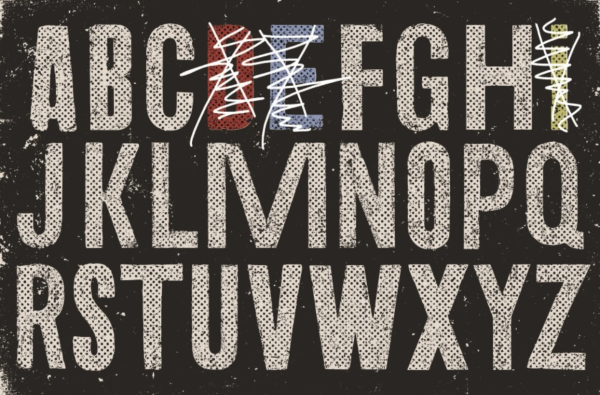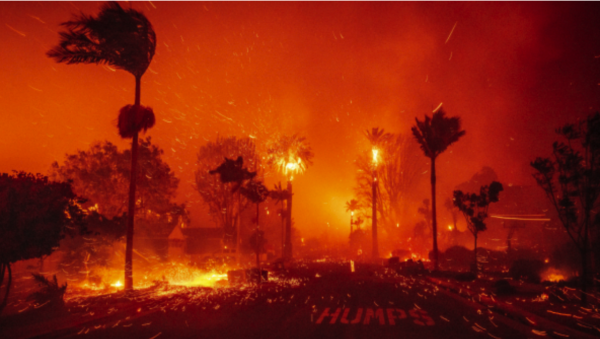JanTerm: A history of its past and a sneak peek into its future
This article is an extended version from the print issue.
Making its way into the curriculum this year, JanTerm is an innovative, fast-paced “minimester” that is set to take place during the first three weeks of the second semester. The idea came into fruition after a thorough planning process, launched by the Board of Trustees, which was aimed at maximizing efficiency and engagement in the classroom. Assistant principal Jim Justice’s “Time Task Force” headed this initiative. With the combined efforts of both students and teachers, the Task Force researched and planned for months. After visiting other groundbreaking schools and surveying for student input, they ultimately came up with the idea of JanTerm.
“We knew from summer school that for a lot of kids being able to focus on one course instead of having to juggle five makes a big difference both in the way they learn and in their level of engagement during class, especially since some classes are more hands on,” said Justice. “Also, we saw that a few other schools, such as the Hawken School in Cleveland, had a similar idea to JanTerm that worked well for them, which only made us more enthusiastic.”
Comprised of a total of 43 course offerings, JanTerm lets students to choose from variety of fields including electronic fashion, Hollywood music, Shakespeare, and much more. However, its distinctness not only derives from the types of class but also from how those classes are taught. Resembling the Spanish or French Bible classes of the past, most courses will be led by two teachers, often from varying backgrounds.
“I think it’ll be unique to be with two teachers from different disciplines,” said Justice. “Kids seem to really enjoy the interplay of a team-teaching environment. The interdisciplinary aspect is important because that’s ultimately the way humans are; we’re constantly searching to make connections.”
Different from the constantly rotating school environment, students will stick with the same class for three weeks straight, allowing them to become fully absorbed. Due to its intensive nature, the semester creates a time period conducive for field trips, in-depth explorations, and even travelling abroad.
“Above all, I think it’s just going to be fun to do things like get off campus or have assessments where you have to build things,” said Justice, “like a remote-controlled plane or a wind tunnel.”
As students get ready for Jregistration, which will take place in their respective homerooms on Sept. 29 and Sept. 30, they must narrow down the choices to their top five favorites. To aid in this difficult process, here are some sneak peeks on a few of these diverse courses.
Entrepreneurship: An Introduction
Along with organizing and setting up much of the JanTerm, Justice will also be participating in the term by co-teaching a class on entrepreneurship. However, the course is not only distinctive for its topic but also for its second teacher: president and CEO of Johnson Media, Kevin D. Johnson.
“We’ve got an incredible guest professor lined up,” Justice said. “He’s a young, successful entrepreneur who was persuasive in the way he talked about his enthusiasm for working with high school kids. We’re pretty excited about him.”
The class aims at educating young entrepreneurs using Johnson’s book, The Entrepreneur’s Mind, as its guiding textbook. Students will also get the chance to explore the entrepreneurship network within the city by visiting business owners and leaders throughout the Atlanta community. Finally, Justice hints at, the semester will finish with an intense, “TV drama”-like challenge.
“The concluding project will most likely resemble a Shark Tank episode,” he said. “Ideally, some of the folks who had been guest lecturers or who we had visited during the course would act as the potential investors for students.”
From Zumba to Hip-Hop: Contemporary Forms of Community-Generated Expression in Atlanta
Spanish teacher Estefania Olid and English teacher Jennifer Dracos-Tice join forces to lead a class focused on alternative forms of expression, especially within the context of the city. With a history as long as the course title, Olid and Dracos-Tice first worked together while supervising the 2013 Argentina Exchange trip. With common interests in exploring linguistics and rhetoric in their more modern genres, they saw the potential for a class that encompassed their passions.
“It just made sense,” said Olid. “Both us were interested in how people tell their stories and how they express what they care about in modes that have definite forms and artistic merit, but more importantly that come from the community.”
As Olid instructs the zumba club and Dracos-Tice presides over the Evolutions magazine, they brought their respective backgrounds together to teach about a variety of forms of expression, spanning from cha-cha-chá and el son cubano to rap and spoken word. Though this range seems wide, the two are more interested in delving into the historical and cultural basis behind each mode.
“I think we’re going to be looking at a number of different forms of community-based expression,” said Dracos. “So whether that involves going into the community and taking a salsa or tango class, or even an African drumming class, we believe in the importance of learning the history of how and why those things emerged.”
After gaining more experience by attending dance or music classes, visiting Open Mics in the city, or hosting their own speakers’ corners, students will take their education to the next level in the form of a performance.
“It’s interesting to see how the written word transcends what’s on paper and becomes performativity, especially in the community sense,” Olid said. “So, the students in the class will have to not only have to learn, but they will also have to perform… publically!”
This “dynamic portfolio,” which allows students to express apply themselves in a hands-on culmination of what they’ve learned, demonstrates one of the integral ideas behind JanTerm’s creation.
If You Build It: Designing Stadiums for Communities
With two massive stadium projects taking place within Atlanta, this course explores the impact that stadiums and their construction have on the communities in which they’re build. English department chair Bart Griffith and economics teacher Mark Labouchere want students to dive into the major inquiries surrounding stadiums, especially by looking past the sports-crazed culture and into the idea that stadiums greatly affect people living around them.
“This course gives students the opportunity to seize upon and participate in a pretty wide range of conversation in the life of Atlanta, which brings up the question, ‘Why are we dedicating millions and millions of dollars to stadium build?’ said Griffith. “We want to examine the drive to build them and to also explore the myths and realities that go into their construction.”
The class, which stemmed from a summer school course run by former English teacher Geoffrey Sudderth, has evolved into one that takes the students into the heart of Atlanta to experience firsthand the influence of these significant structures. With frequent day trips to places such as the new Braves stadium in Cobb County or the Georgia Dome, students will be able to interact with professionals closely involved in the building process and design.
“All of this is really relevant because it’s happening live, and so we’re hoping the kids will get to engage with the architects, the developers, and all the people involved in the projects,” Griffith said. “We want them to be able to learn from as many different perspectives as possible about the benefits and opportunities as well as the challenges in stadium design.”
By incorporating a design initiative led by the students that looks at ways to help with the stadium build, Griffith and Labouchere are strongly connected with the public aspect behind what they’re trying to teach. Ultimately, they endeavor to change people’s’ perspectives on stadiums from something that simply houses a team to something that can transform an entire community.
“My biggest hope is that students will feel more connected to issues in their city, and that they’ll come away with a sense of the value of their own voice and critical thinking,” said Griffith. “Also, every time they go to a stadium, they’ll hopefully start to think about it a little differently, like how the entire enterprise of stadium building can impact the community.”
The Business of Sports
As athletics are a huge component to the makeup of the Westminster community, there’s no wonder that teachers want to lead classes about it. The roster for this course is stacked with coaches Amy Eubanks, Marty Wild, Bobby Hayes, and Eric Lougas, people who know their sports. Seeing sports instead from an operational standpoint, they hope to educate students on the complexity of sports management.
“To me, the general business operations [are very interesting] because you think of how to make sports team as a whole run,” said Lougas. “Getting a team together, getting the flights, getting the buses to and from the hotel, feeding [the athletes], there’s a lot of stuff, and it’s got to work like clockwork.”
Additionally, these coaches want to illustrate that behind the team itself exists an in depth network of coordinators that are necessary for everything to function.
“There are more layers to it that the students realize,” said Eubanks. “For example, public relations can include statistics, promotions, and just many more layers. I think that this is a lot bigger, a lot deeper, and a lot more involved… like the training and the sports performance aspects of it.”
To gain this understanding, students will embark on a number of different field trips to major sports teams in Georgia, such as the Falcons or the Bulldogs. Once there, they will have the opportunity to explore the facilities, meet with directors and managers in charge, and learn about all the inner workings.
“We’ll be doing some simulations, we’ll have guest speakers, and we’ll be going to different venues,” Wild said. “We’ll be going to the Georgia Dome as well as to Georgia State, Georgia Tech, and other collegiate and professional avenues. We’ll also probably go to some merchandising stores just to see some different things. We want to bring people in that specialize in many different areas.”
Furthermore, the class aims to incorporate as diverse a spectrum as possible so that students can comprehend the variation between different sports programs.
“We’re going to reach out to as many pro teams as we can. [In Atlanta] we’ve got everything with the exception of hockey, and we even have minor league hockey,” said Hayes. “There’re so many schools in town, maybe we can get with UGA, where they’ve got around 100 million dollars to spend, versus LaGrange College, which has a limited budget. So we can compare and contrast the two of those.”
As the semester comes to a close, the coaches want to challenge the students to create a project in which they design their own sports program or business. In doing so, students will test their knowledge by managing different components of the business to make sure everything runs smoothly. Overall, the course uncovers this important part of sports and its management that often remains hidden from the eyes of the athletes but is still crucial to the survival of a team or program.
“For students that are interested in sports and play sports, this [course] goes totally away from the sporting field and just sees what happens behind-the-scenes,” said Lougas. “So I think it’s important to know this, especially because you have students going to play college sports. Whether they play football or tennis… there’s a lot of stuff going on, and it’s important that everyone’s going to have a, really good experience doing it.”
The Symphony Orchestra: A Party from the Past Reimagined for the Future
Band director Freddy Martin and orchestra director Linda Cherniavsky will collaborate to teach a symphony orchestra course that will include activities such as crafting an instrument by hand, trying out a variety of different instruments, and attending concerts regularly. Martin is primarily in charge of getting in touch with professional musicians, while Cherniavsky has been reaching out to people working as part of the management of the Atlanta Symphony Orchestra, or ASO. A combination of their efforts will provide students with the opportunity to venture behind-the-scenes and discover how a typical symphony orchestra is run from day to day.
“I wanted to do something about music, and because [the ASO] is a major orchestra in our city, I wanted to strengthen the relationship of our students to that artistic institution,” said Cherniavsky. “And Mr. Martin loves symphonic literature and music, so we thought that doing a course around a symphony orchestra would be a good basis for developing a class.”
Ever since the course was first conceptualized, the two directors have been meeting weekly to discuss all that it will entail. In the first week of the course, students will visit a DeKalb Symphony Orchestra rehearsal to discover what a typical rehearsal setting is like. Additionally, the class will travel to Atlanta Symphony Hall on Thursdays to go to ASO rehearsals and learn about the orchestra’s current repertoire. Students will be allocated a period of time to meet with the musicians and management before they have dinner and attend the evening concert.
Throughout Jan Term, a variety of professional musicians from the Atlanta area and beyond will also come in and share their expertise.
“We’re bringing in a percussionist from Georgia State—John Lawless—to show us the history of percussion instruments, how they ended up in the symphony orchestra, and what their function is,” said Martin. “Professor Lawless is an amazing clinician, so that’ll be fun for anyone who’s fortunate enough to be there when he gives his clinic.”
Other musicians that are slated to make appearances include Chris Martin, the principal trumpeter of the Chicago Symphony Orchestra, who will Skype or FaceTime the class to discuss ASO pieces that he’s familiar with. Freddy Martin has also confirmed guest speakers such as ASO trumpeter Michael Tiscione and his wife Elizabeth Koch Tiscione, principal oboist of the ASO. The students may even have the chance to meet with Robert Spano, the music director of the ASO.
At some point, students will be given the chance to try out the variety of instruments that are played by symphony orchestra musicians. Everyone in the class will experiment with instruments from the string, woodwind, brass, and percussion families.
“We want people to have a deeper understanding of the entire orchestra,” said Cherniavsky. “If they play an instrument already, they have an understanding of their instrument, but they might not necessarily know how a cello or a double bass works, or a woodwind player might not know how a tuba player functions in an orchestra.”
Students will create their own instruments from scratch as well.
“You can build a flute, you can build a violin,” said Martin. “If you’re extraordinary with your hands, you could build a cello. There’s a junk orchestra in South America that plays instruments that they literally put together from junkyards, and we’re going to look at that so [the students] can get an idea of how they might want to build their own instruments.”
This Jan Term course will culminate with a service-based final project in the form of a marketing campaign that will try to encourage members of the school community to attend future Atlanta Symphony Orchestra concerts. Students can create anything from custom email blasts to a five-minute commercial to be shown during a school assembly in order to persuade students to travel down to Atlanta and experience the ASO’s music in person.
“These days, we’re so focused on our own personal sphere,” said Cherniavsky. “We have connection to the outside world digitally, but we don’t have the live, crowded mass experience that going to a symphony orchestra concert is like. I think it’s very important for people to learn how to listen to music and to learn about the concert experience.”
Overall, the course is meant to appeal to not only musicians who are interested in the administration and everyday functioning of a symphony orchestra, but also curious, non-musician members of the school community as well. No prior musical experience is required.
“My hope is that students won’t look at this class as a stuffy class because it’s not going to be stuffy,” said Martin. “It’s going to be extraordinarily fun and enjoyable to see how all of these pieces of the puzzle fit together to create a piece of art that really is quite special.”
As January approaches, there is an excitement buzzing in the air. More and more, questions like ‘Which course do you want to take?’ are being asked throughout the school. With the plethora of options available, students will surely have a hard time narrowing it down. However, no matter what class students elect to take, they are bound to have an energizing three weeks.
“All of these courses look really interesting and there are just some legendary teachers leading them,” said Justice. “So, I think we’re all definitely looking forward to it.”




